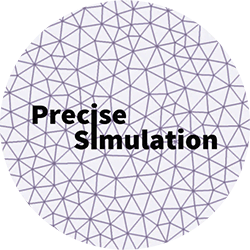
|
FEATool Multiphysics
v1.17.5
Finite Element Analysis Toolbox
|

|
FEATool Multiphysics
v1.17.5
Finite Element Analysis Toolbox
|
EX_HEATTRANSFER8 Space-time heat diffusion with analytic solution.
[ FEA, OUT ] = EX_HEATTRANSFER8( VARARGIN ) One dimensional transient heat diffusion problem converted to a 2D space-time finite element formulation with analytic solution. A 1 m rod is kept at fixed temperature on one end and constant outward heat flux at the other end as in the following illustration.
+---------- L=1m ----------+ T = 25
q_n = 1 T(t=0) = 25
Accepts the following property/value pairs.
Input Value/{Default} Description
-----------------------------------------------------------------------------------
hmax scalar {0.1} Grid cell size in x-direction
igrid scalar {0}/1/2 Cell type (0=quadrilaterals, 1=triangles,
sfun string {sflag1} Finite element shape function
solver string fenics/{} Use FEniCS or default solver
tmax scalar {0.2} Maximum time
tstep scalar {0.01} Time step discretization size (y-direction)
iplot scalar {1}/0 Plot solution (=1)
.
Output Value/(Size) Description
-----------------------------------------------------------------------------------
fea struct Problem definition struct
out struct Output struct
cOptDef = { 'hmax', 0.025;
'igrid', 0;
'sfun', 'sflag1';
'solver', '';
'tmax', 0.2;
'tstep', 0.01;
'iplot', 1;
'tol', 1e-2;
'fid', 1 };
[got,opt] = parseopt(cOptDef,varargin{:});
% Geometry definition.
gobj = gobj_rectangle( 0, 1, 0, opt.tmax );
fea.geom.objects = { gobj };
% Grid generation.
switch opt.igrid
case 0
fea.grid = rectgrid( round(1/opt.hmax), ceil(opt.tmax/opt.tstep), [0, 1; 0, opt.tmax] );
case 1
fea.grid = gridgen( fea, 'hmax', min(opt.hmax,opt.tstep), 'fid', opt.fid );
case 2
fea.grid = rectgrid( round(1/opt.hmax), ceil(opt.tmax/opt.tstep), [0, 1; 0, opt.tmax] );
fea.grid = quad2tri( fea.grid, 1 );
end
% Problem definition.
fea.sdim = { 'x', 'yt' }; % Space and time coordinate names.
fea = addphys( fea, @heattransfer ); % Add heat transfer physics mode.
fea.phys.ht.sfun = { opt.sfun }; % Set shape function.
% Equation coefficients.
fea.phys.ht.eqn.coef{1,end} = 1; % Density (rho_ht).
fea.phys.ht.eqn.coef{2,end} = 1; % Heat capacity (cp_ht).
fea.phys.ht.eqn.coef{3,end} = 1; % Thermal conductivity (k_ht).
fea.phys.ht.eqn.coef{4,end} = 0; % Convection in x-direction (u_ht).
fea.phys.ht.eqn.coef{5,end} = 1; % Time convection coefficient (v_ht).
fea.phys.ht.eqn.coef{6,end} = 0; % Heat source term (q_ht).
fea.phys.ht.eqn.coef{7,end} = { 25 }; % Initial temperature.
% Redefine equation.
fea.phys.ht.eqn.seqn = '-k_ht*Tx_x + rho_ht*cp_ht*u_ht*Tx_t + rho_ht*cp_ht*v_ht*Tyt_t = q_ht';
% Boundary conditions.
fea.phys.ht.bdr.sel = [ 1 1 2 4 ];
fea.phys.ht.bdr.coef{1,end} = { 25 25 [] [] };
fea.phys.ht.bdr.coef{4,end}{4}{1} = -1;
% Parse physics modes and problem struct.
fea = parsephys(fea);
fea = parseprob(fea);
% Compute solution.
if( strcmp(opt.solver,'fenics') )
fea = fenics( fea, 'fid', opt.fid, 'nproc', 1 );
else
fea.sol.u = solvestat( fea, 'fid', opt.fid );
end
% Postprocessing.
T_ref = refsol( fea.grid.p(1,:)', fea.grid.p(2,:)' );
if( opt.iplot>0 )
subplot(1,2,1)
postplot( fea, 'surfexpr', 'T', 'surfhexpr', 'T', 'boundary', 'off' )
view(3)
title( 'Computed Temperature' )
xlabel('x')
ylabel('time')
zlabel('T')
axis( [0 1 0 opt.tmax 0.95*min(fea.sol.u) 1.05*max(fea.sol.u)] )
axis tight
grid on
subplot(1,2,2)
fea.vars(1).name = 'T_ref';
fea.vars(1).descr = 'Reference Temperature';
fea.vars(1).data = T_ref(:);
postplot( fea, 'surfexpr', 'T_ref', 'surfhexpr', 'T_ref', 'boundary', 'off' )
view(3)
title( 'Reference Temperature' )
xlabel('x')
ylabel('time')
zlabel('T_{ref}')
axis( [0 1 0 opt.tmax 0.95*min(fea.sol.u) 1.05*max(fea.sol.u)] )
axis tight
grid on
rotate3d('on')
end
% Error checking.
T_sol = evalexprp( 'T', fea );
out.err = norm( abs(T_sol-T_ref)/T_ref );
out.pass = out.err<opt.tol;
if( nargout==0 )
clear fea out
end
% -----------------------------------